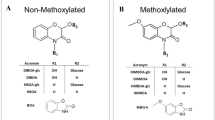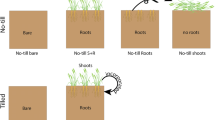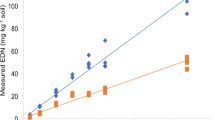Abstract
Rye (Secale cereale L.) residue is known to suppress weeds in agronomic environments and to produce benzoxazinoid (BX) compounds which are phytotoxic. Experiments were conducted to determine the duration of indicator plant inhibition and BX soil concentrations in response to field incorporated or surface rye residue. Surface rye residue was highly inhibitory to lettuce (Lactuca sativa L.) and smooth pigweed (Amaranthus hybridus L.) throughout an experimental period of 4 weeks, whereas soil removed from beneath residue and assayed in pots had little phytotoxicity, suggesting that physical rather than chemical mechanisms were involved. Incorporated residue inhibited lettuce and pigweed for approximately 2 weeks after incorporation, which corresponded to the period when elevated BX levels were detected in soil, suggesting potential allelopathy. The most toxic BX compounds, APO, DIBOA, and DIMBOA, were present at relatively low levels, whereas the less toxic compounds, BOA and MBOA, and the non-toxic compounds, HBOA and HMBOA, were the predominant BX species in amended soils. When the benzoxazolinones BOA and MBOA were exogenously added to soils to maintain extractable levels of up to 10 μg g−1 soil (100–500 times higher than measured BX in field soils), no significant inhibition of pigweed plants was observed. This result indicated that the observed association between the duration of plant inhibition and BX from incorporated rye was not causal, and that other compounds released with similar dynamics were likely responsible. This approach provides a sound basis for demonstrating the presence of allelopathy in natural or managed ecosystems.





Similar content being viewed by others
References
Barnes JP, Putnam AR (1983) Rye residues contribute weed suppression in no-tillage cropping systems. J Chem Ecol 9:1045–1057
Barnes JP, Putnam AR (1987) Role of benzoxazinones in allelopathy by rye. J Chem Ecol 13:889–906
Barnes JP, Putnam AR, Burke BA, Aasen AJ (1987) Isolation and characterization of allelochemicals in rye herbage. Phytochemistry 26:1385–1390
Belz RG, Hurle K (2005) Differential exudation of two benzoxazinoids—one of the determining factors for seedling allelopathy of Triticeae species. J Agric Food Chem 53:250–261
Burgos NR, Talbert RE (2000) Differential activity of allelochemicals from Secale cereale in seedling bioassays. Weed Sci 48:302–310
Burgos NR, Talbert RE, Mattice JD (1999) Cultivar and age differences in the production of allelochemicals by Secale cereale. Weed Sci 47:481–485
Carlsen SCK, Kudska P, Laursen B, Mathiassen SK, Mortensen AG, Fomsgaard IS (2009) Allelochemicals in rye: cultivar and tissue differences in the production of benzoxazinoids and phenolic acids. Nat Prod Commun 4:199–208
Clark A (2007) Managing cover crops profitably, 3rd edn. Sustainable agriculture. Network, Handbook series book 9, Beltsville
Conklin AE, Erich MS, Liebman M, Lambert D, Gallandt ER, Halteman WA (2002) Effects of red clover green manure and compost soil amendments on wild mustard growth and incidence of disease. Plant Soil 238:245–256
Dabney SM, Schreiber JD, Rothrock CS, Johnson JR (1996) Cover crops affect sorghum seedling growth. Agron J 88:961–970
Davis A (2010) Cover-crop roller-crimper contributes to weed management in no-till soybean. Weed Sci 58:300–309
Gagliardo RW, Chilton WS (1992) Soil transformation of 2(3H)-benzoxazolone of rye into phytotoxic 2-amino-3H-phenoxazin-3-one. J Chem Ecol 18:1683–1691
Hiradate S, Ohse K, Furubayashi A, Fujii Y (2010) Quantitative evaluation of allelopathic potentials in soils: total activity approach. Weed Sci 58:258–264
Inderjit (2001) Soil: environmental effects on allelochemical activity. Agron J 93:79–84
Krogh SS, Mensz SJM, Nielsen ST, Mortensen AG, Christophersen C, Fomsgaard IS (2006) Fate of benzoxazinone allelochemicals in soil after incorporation of wheat and rye sprouts. J Agric Food Chem 54:1064–1074
Kruidhof HM, Bastiaans L, Kropff MJ (2009) Cover crop residue management for optimizing weed control. Plant Soil 318:169–184
Macías FA, Marín D, Oliveros-Bastidas A, Castellano D, Simonet AM, Molinillo JMG (2005a) Structure-activity relationship studies of benzoxazinones, their degradation products, and analogues. Phytotoxicity on standard target species. J Agric Food Chem 53:538–548
Macías FA, Oliveros-Bastidas A, Marín D, Castellano D, Simonet AM, Molinillo JMG (2005b) Degradation studies on benzoxazinoids. Soil degradation dynamics of (2R)-2-O-β-d-glucopyranosyl-4-hydroxy-(2H)-1,4-benzoxazin-3(4H)-one (DIBOA-glc) and its degradation products, phytotoxic allelochemicals from Gramineae. J Agric Food Chem 53:554–561
Macías FA, Marín D, Oliveros-Bastidas A, Castellano D, Simonet AM, Molinillo JMG (2006) Structure-activity relationship studies of benzoxazinones, their degradation products, and analogues. Phytotoxicity on problematic weeds Avena fatua L. and Lolium rigidum Gaud. J Agric Food Chem 54:1040–1048
Reberg-Horton SC, Burton JD, Danehower DA et al (2005) Changes over time in the allelochemical content of ten cultivars of rye. J Chem Ecol 31:179–193
Rice CP, Park YB, Adam F, Abdul-Baki AA, Teasdale JR (2005) Hydroxamic acid content and toxicity of rye at selected growth stages. J Chem Ecol 31:1887–1905
Rice CP, Cai G, Teasdale JR (2012) Concentrations and allelopathic effects of benzoxazinoid compounds in soil treated with rye cover crop. J Agric Food Chem 60:4471–4479
Teasdale JR, Mohler CL (1993) Light transmittance, soil temperature, and soil moisture under residue of hairy vetch and rye. Agron J 85:673–680
Teasdale JR, Mohler CL (2000) The quantitative relationship between weed emergence and the physical properties of mulches. Weed Sci 48:385–392
von Rad U, Hϋttl R, Lottspeich F, Gierl A, Frey M (2001) Two glucosyltransferases are involved in detoxification of benzoxazinoids in maize. Plant J 28:633–642
Xuan TD, Tawata S, Khanh TD, Chung IM (2005) Decomposition of allelopathic plants in soil. J Agron Crop Sci 191:162–171
Yenish JP, Worsham AD, Chilton WS (1995) Disappearance of DIBOA-glucoside, DIBOA, and BOA from rye cover crop residue. Weed Sci 43:18–20
Author information
Authors and Affiliations
Corresponding author
Rights and permissions
About this article
Cite this article
Teasdale, J.R., Rice, C.P., Cai, G. et al. Expression of allelopathy in the soil environment: soil concentration and activity of benzoxazinoid compounds released by rye cover crop residue. Plant Ecol 213, 1893–1905 (2012). https://doi.org/10.1007/s11258-012-0057-x
Received:
Accepted:
Published:
Issue Date:
DOI: https://doi.org/10.1007/s11258-012-0057-x




